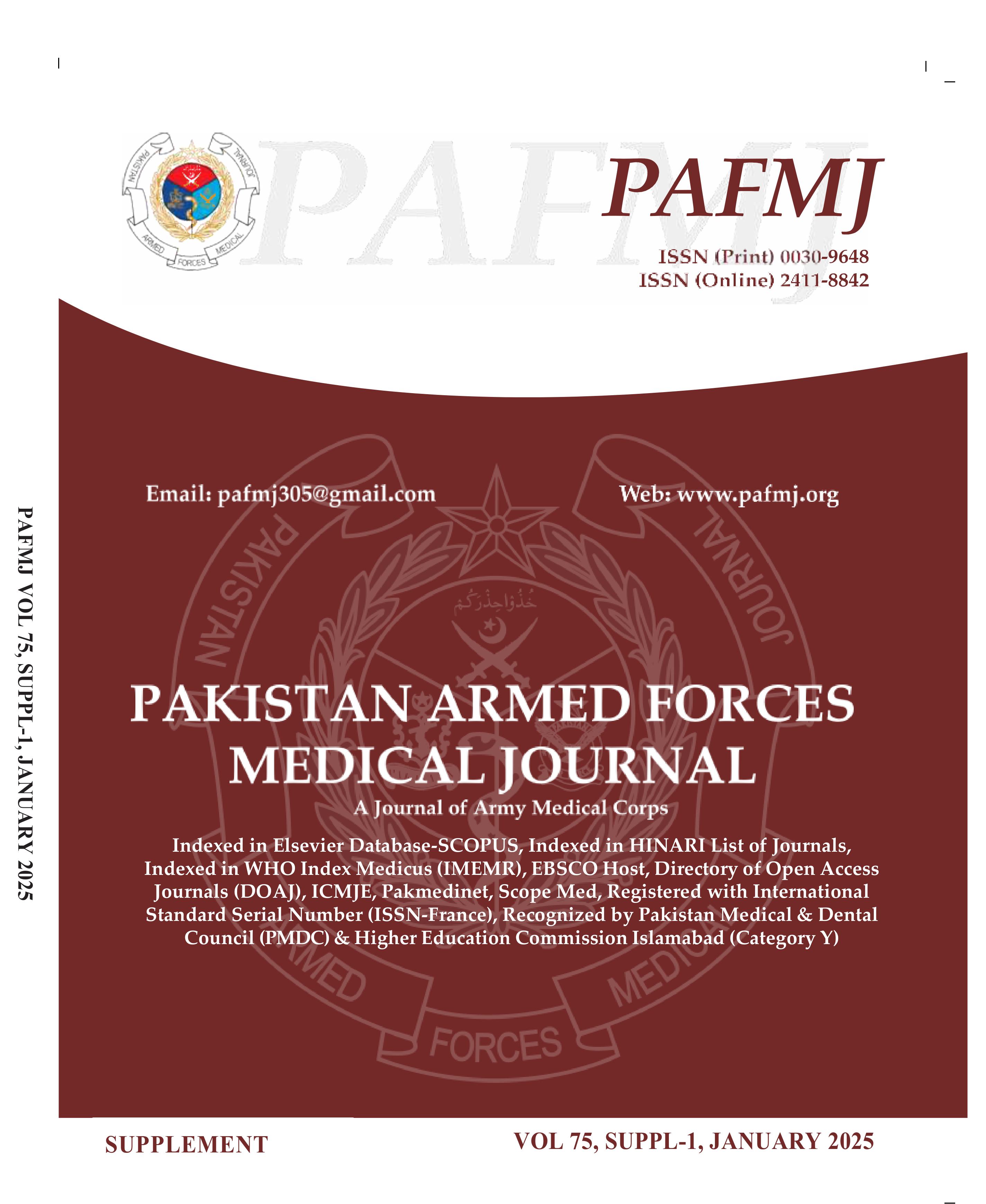Assessment of Insulin Injection Practices in Patients With Diabetes Presenting to a Tertiary Care Hospital
DOI:
https://doi.org/10.51253/pafmj.v75iSUPPL-1.6189Keywords:
Diabetes Mellitus; Insulin; Injection TechniquesAbstract
Objective: To assess insulin insertion practices, including storage, injection techniques and sharps waste disposal in patients with diabetes using insulin syringes and pen-filled insulin.
Study Design: Cross-section study
Place and Duration of Study: Department of Endocrinology, Pak-Emirates Military Hospital Rawalpindi, Pakistan from March to May 2020.
Methodology: All insulin-dependent patients with diabetes were interviewed according to a questionnaire and their insulin insertion techniques and practices assessed. Questionnaire was based on the American Diabetes Association guidelines for insulin insertion. Those who had incorrect practices were later counselled about the correct practices.
Results: 84(70%) participants used insulin syringe for insulin insertion, while 36(30%) used pen-filled insulin. Three-quarters of the patients reported that they were never taught by any healthcare professional regarding correct insulin insertion techniques. 69(57.5%) of those using insulin syringe cleaned the insertion site before injecting insulin, while only 51(22.2%) of those using pen-filled insulin did so. 25(20.6%) of the participants did not wash their hands with soap prior to insulin injection. 68(56.7%) of the participants did not maintain cold chain. Most of the patients 92(77%) disposed off their insulin sharps in household garbage.
Conclusion: There was a significant gap between insulin insertion guidelines and current insulin injection practices. Education and proper counseling should be provided to the patients using insulin by healthcare professionals and their practices should be checked on every out-patient encounter.
Downloads
References
Glovaci D, Fan W, Wong ND. Epidemiology of Diabetes Mellitus and Cardiovascular Disease. Curr Cardiol Rep. 2019 Mar 4; 21(4): 21. https://doi: 10.1007/s11886-019-1107-y.
Adnan M, Aasim M. Prevalence of Type 2 Diabetes Mellitus in Adult Population of Pakistan: A Meta-Analysis of Prospective Cross-Sectional Surveys. Ann Glob Health. 2020 Jan 31; 86(1): 7. https://doi: 10.5334/aogh.2679.
Zia A, Kiani AK, Bhatti A, John P. Genetic susceptibility to type 2 diabetes and implications for therapy. J Diabetes Metab. 2013 Apr 1; 4(248): 2.
Dunbar JM, Madden PM, Gleeson DT, Fiad TM, McKenna TJ. Premixed insulin preparations in pen syringes maintain glycemic control and are preferred by patients. Diabetes Care. 1994 Aug; 17(8): 874-8. https://doi: 10.2337/diacare.17.8.874.
Heinemann L, Braune K, Carter A, Zayani A, Krämer LA. Insulin Storage: A Critical Reappraisal. J Diabetes Sci Technol. 2021 Jan; 15(1): 147-159. https://doi: 10.1177/1932296819900258.
Dong Y, Li F, Li J, Li R, Wang Q. Multicenter cross-sectional study on the reporting status and influencing factors of needlestick injuries caused by insulin injection devices among nurses in Peking, China. Am J Infect Control. 2020 Jul; 48(7): 805-809. https://doi: 10.1016/j.ajic.2019.10.021.
Steenkamp D, Eby EL, Gulati N, Liao B. Adherence and Persistence to Insulin Therapy in People with Diabetes: Impact of Connected Insulin Pen Delivery Ecosystem. J Diabetes Sci Technol. 2021 Mar 5:1932296821997923.
https://doi: 10.1177/1932296821997923.
Strauss, K., Gols, H.D., Hannet, I., Partanen, T.‐M. and Frid, A. (2002), A pan‐European epidemiologic study of insulin injection technique in patients with diabetes. Pract Diab Int, 19: 71-76.
https://doi.org/10.1002/pdi.314.
Gorska-Ciebiada M, Masierek M, Ciebiada M. Improved insulin injection technique, treatment satisfaction and glycemic control: Results from a large cohort education study. J Clin Transl Endocrinol. 2020 Feb 4; 19: 100217.
https://doi: 10.1016/j.jcte.2020.100217.
American Diabetes Association. Insulin administration. Diabetes Care. 2004 Jan 1; 27(suppl 1):s106-7.
Patil M, Sahoo J, Kamalanathan S, Selviambigapathy J, Balachandran K, Kumar R, Vivekanandan M, Ajmal K. Assessment of insulin injection techniques among diabetes patients in a tertiary care centre. Diabetes Metab Syndr. 2017 Nov;11 Suppl 1: S53-S56. https://doi: 10.1016/j.dsx.2016.09.010.
Poudel RS, Shrestha S, Piryani RM, Basyal B, Kaucha K, Adhikari S. Assessment of Insulin Injection Practice among Diabetes Patients in a Tertiary Healthcare Centre in Nepal: A Preliminary Study. J Diabetes Res. 2017; 2017: 8648316.
https://doi: 10.1155/2017/8648316.
Frid AH, Kreugel G, Grassi G, Halimi S, Hicks D, Hirsch LJ, Smith MJ, Wellhoener R, Bode BW, Hirsch IB, Kalra S, Ji L, Strauss KW. New Insulin Delivery Recommendations. Mayo Clin Proc. 2016 Sep; 91(9): 1231-55.
https://doi: 10.1016/j.mayocp.2016.06.010.
Baker E. Ahmed, A., Badgandi, M. and Home, P.D. (2001), Interval between insulin injection and meal in relation to glycated haemoglobin. Pract Diab Int, 18: 51-56.
https://doi.org/10.1002/pdi.126.
Müller N, Frank T, Kloos C, Lehmann T, Wolf G, Müller UA. Randomized crossover study to examine the necessity of an injection-to-meal interval in patients with type 2 diabetes and human insulin. Diabetes Care. 2013 Jul; 36(7): 1865-9. https://doi: 10.2337/dc12-1694.
Basazn Mekuria A, Melaku Gebresillassie B, Asfaw Erku D, Taye Haile K, Melese Birru E. Knowledge and Self-Reported Practice of Insulin Injection Device Disposal among Diabetes Patients in Gondar Town, Ethiopia: A Cross-Sectional Study. J Diabetes Res. 2016; 2016: 1897517.
https://doi: 10.1155/2016/1897517.
Olowokure B, Duggal H, Armitage L. The disposal of used sharps by diabetic patients living at home. Int J Environ Health Res. 2003 Jun; 13(2): 117-23.
https://doi: 10.1080/0960312031000098044.
Tandon N, Kalra S, Balhara YPS, Baruah MP. Forum for Injection Technique and Therapy Expert Recommendations, India: The Indian Recommendations for Best Practice in Insulin Injection Technique, 2017. Indian J Endocrinol Metab. 2017 Jul-Aug; 21(4): 600-617. https://doi: 10.4103/ijem.IJEM_97_17.
Mehmood MS, Munir MW, Baig WS, Ansari AM, Saddiq S, Farooq M. Knowledge of Diabetic patients about Insulin injection technique. Professional Med J. 2019 Dec 10; 26(12): 2122-7.
Ogle GD, Abdullah M, Mason D, Januszewski AS, Besançon S. Insulin storage in hot climates without refrigeration: temperature reduction efficacy of clay pots and other techniques. Diabet Med. 2016 Nov; 33(11): 1544-1553.
https://doi: 10.1111/dme.13194.
Janjua NZ. Injection practices and sharp waste disposal by general practitioners of Murree, Pakistan. J Pak Med Assoc. 2003 Mar; 53(3): 107-11.
Downloads
Published
Issue
Section
License
Copyright (c) 2025 Muneeb ur Rehman, Bilal Ahmad, Khurshid Muhammad Uttra

This work is licensed under a Creative Commons Attribution-NonCommercial 4.0 International License.















